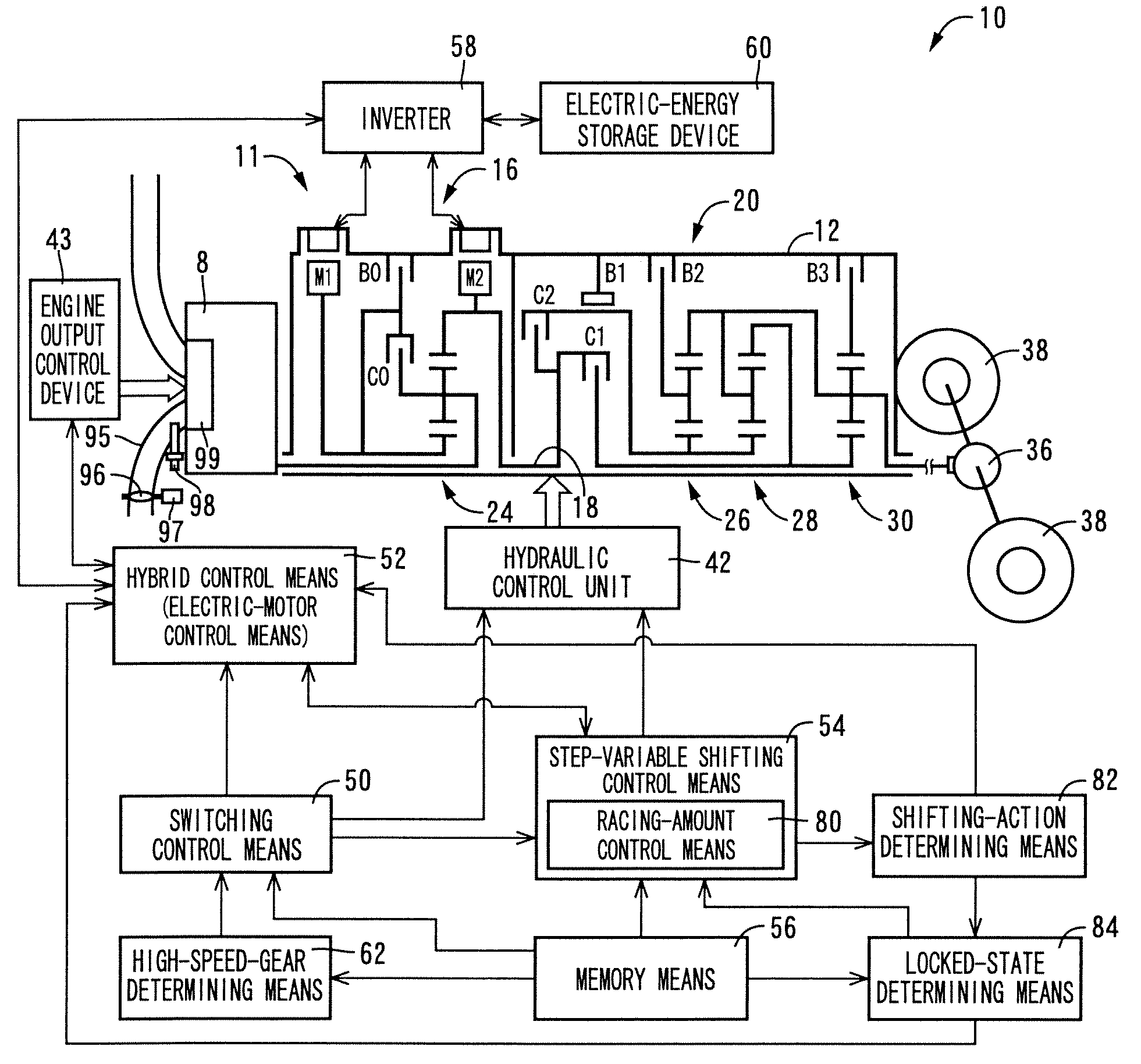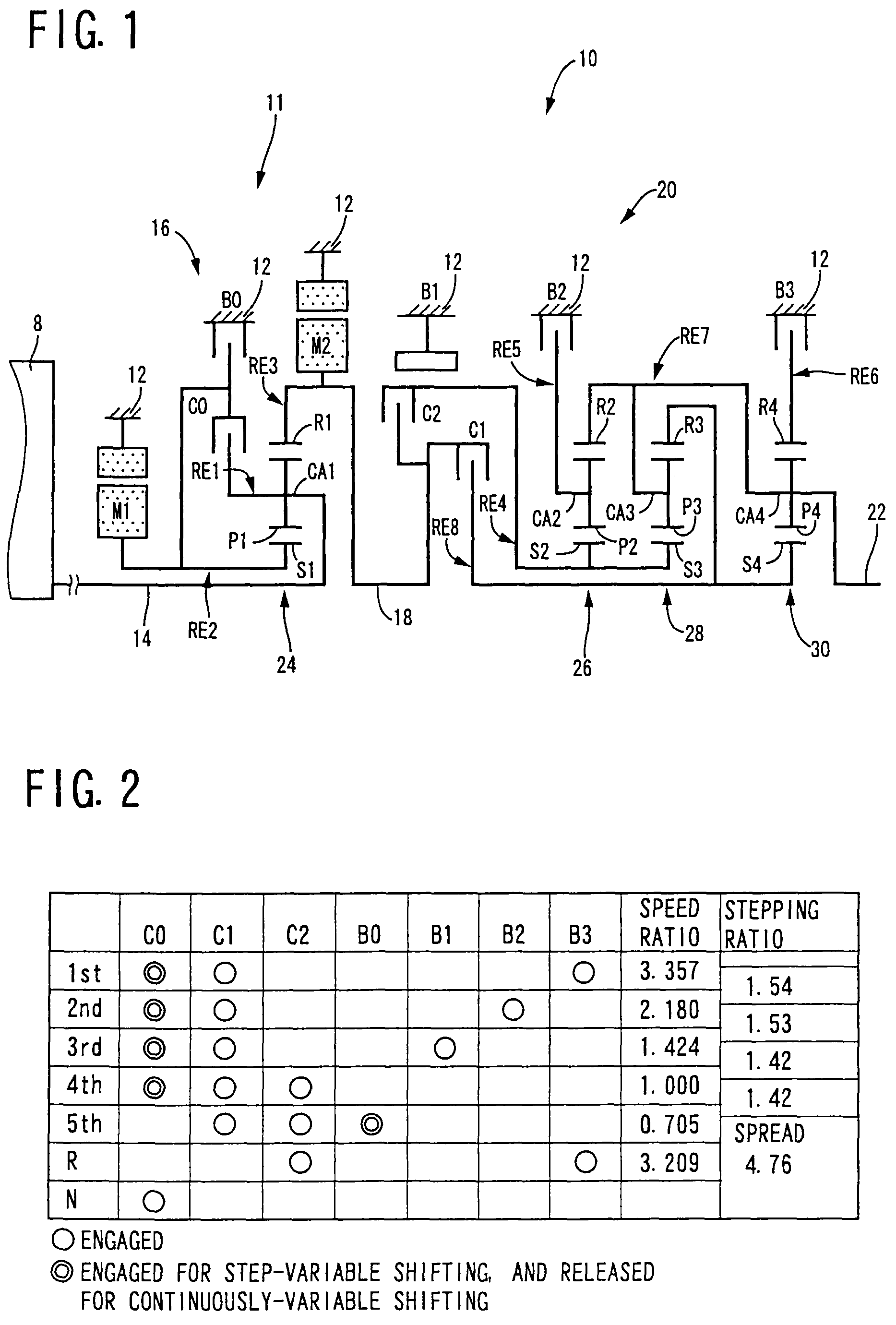Controller of driver for vehicles
a controller and vehicle technology, applied in the direction of machines/engines, vehicle sub-unit features, gearing, etc., can solve the problems of deteriorating fuel economy of vehicles, inability to provide any power transmission mechanism having the advantages, and the vehicular drive system suffering from similar problems, so as to reduce the required size of the second electric motor, and improve the efficiency of the continuously variable shifting control of the continuously variable transmission portion
- Summary
- Abstract
- Description
- Claims
- Application Information
AI Technical Summary
Benefits of technology
Problems solved by technology
Method used
Image
Examples
embodiment 1
[0067]FIG. 1 is a schematic view for explaining an a transmission mechanism 10 constituting a part of a drive system for a hybrid vehicle, which drive system is controlled by a control apparatus according to one embodiment of this invention. In FIG. 1, the transmission mechanism 10 includes: an input rotary member in the form of an input shaft 14; a continuously-variable transmission portion in the form of a differential portion 11 connected to the input shaft 14 either directly, or indirectly via a pulsation absorbing damper (vibration damping device) not shown; a step-variable or multiple-step transmission portion in the form of an automatic transmission portion 20 disposed between the differential portion 11 and drive wheels 38 of the vehicle, and connected in series via a power transmitting member 18 (power transmitting shaft) to the differential portion 11 and the drive wheels 38; and an output rotary member in the form of an output shaft 22 connected to the automatic transmiss...
embodiment 2
[0199]FIG. 14 is a schematic view for explaining an arrangement of a transmission mechanism 70 in another embodiment of this invention, and FIG. 15 a table indicating a relationship between the gear positions of the transmission mechanism 70 and different combinations of engaged states of the hydraulically operated frictional coupling devices for respectively establishing those gear positions, while FIG. 16 is a collinear chart for explaining a shifting operation of the transmission mechanism 70.
[0200]The transmission mechanism 70 includes the differential portion 11 having the first electric motor M1, power distributing mechanism 16 and second electric motor M2, as in the preceding embodiment. The transmission mechanism 70 further includes an automatic transmission portion 72 having three forward drive positions. The automatic transmission portion 72 is interposed between the differential portion 11 and the output shaft 22 and is connected in series to the differential portion 11 t...
embodiment 3
[0208]FIG. 17 shows an example of a seesaw switch 44 (hereinafter referred to as “switch 44”) functioning as a shifting-state selecting device manually operable to select the differential state (non-locked state) or non-differential state (locked state) of the power distributing mechanism 16, that is, to select the continuously-variable shifting state or step-variable shifting state of the transmission mechanism 10. This switch 44 permits the user to select the desired shifting state during running of the vehicle. The switch 44 has a continuously-variable-shifting running button labeled “CONTINUOUSLY-VARIABLE” for running of the vehicle in the continuously-variable shifting state, and a step-variable-shifting running button labeled “STEP-VARIABLE” for running of the vehicle in the step-variable shifting state, as shown in FIG. 17. When the continuously-variable-shifting running button is depressed by the user, the switch 44 is placed in a continuously-variable shifting position for ...
PUM
 Login to View More
Login to View More Abstract
Description
Claims
Application Information
 Login to View More
Login to View More - R&D
- Intellectual Property
- Life Sciences
- Materials
- Tech Scout
- Unparalleled Data Quality
- Higher Quality Content
- 60% Fewer Hallucinations
Browse by: Latest US Patents, China's latest patents, Technical Efficacy Thesaurus, Application Domain, Technology Topic, Popular Technical Reports.
© 2025 PatSnap. All rights reserved.Legal|Privacy policy|Modern Slavery Act Transparency Statement|Sitemap|About US| Contact US: help@patsnap.com



